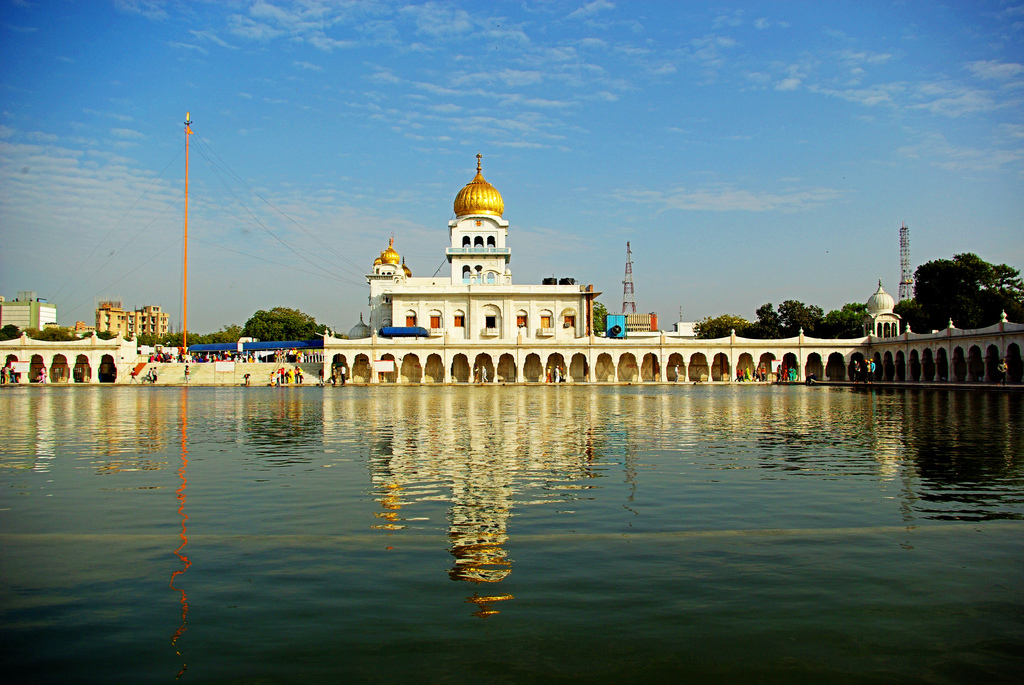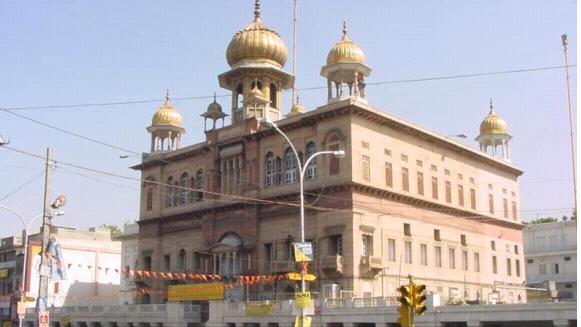Gurdwaras in Delhi
The important capital city of Delhi, has a close and long connection with Sikh history. Not only did five Sikh Gurus visit this city since the late 1400s, but as it was the seat of political power during the first 300 years of the life of the Sikh faith many critical events took place here; unfortunately, the city also witnessed the earthly demise of the lives of two Sikh Gurus here.
There are 9 historic Gurdwaras in Delhi. The most importance ones are listed and described in brief below. The Delhi Sikh Gurdwara Management Committee is responsible for the management of these 9 places of worship. These Gurdwaras are visited daily by many visitors from all faiths. Many local Sikhs, Hindus and Muslims have a regular routine of visiting some of these shrines due to their historic significance.
Background
Due to its proximity to Punjab, Delhi has a significant Sikh influence in its lifestyle. They complete the triangle of composite culture of Delhi along with Hindus and Muslims. Although Sikhs have a very tiny population in Delhi, they are a backbone of trade in the city. Like Muslims, Sikhs too have their dedicated settlements that are scattered all over Delhi. There are many beautiful and magnificent Gurudwaras in Delhi that surely give a feel about the prosperity of this community.
At least two dharmsals had come into existence (at Nanak Piau and Majnu Tilla) during the time of Guru Nanak, the founder of the faith. A community of followers of Sikhism called Dilwali (abbreviated from Dilliwali) sangat lived in Kucha Dilwali Singhan near Ajmeri Gate at least since the middle of the seventeenth century.
Mata Sundari and Mata Sahib Devan lived with this sangat for many years before they shifted temporarily to Mathura in 1725. There are now nine historical Gurdwaras being managed by the Delhi Sikh Gurdwara Management Committee, a statutory body like the Shiromani Gurdwara Parbandhak Committee.
Gurdwara Nanak Piau
Gurdwara Nanak Piau- north of Sabzi mandi along the Grand Trunk Road is where Guru Nanak first arrived near a well. He drew water from the well which he served to travelers or others in need besides propagating the tenets of his monotheistic and humanitarian creed. Piau means a stand where water is served free to the thirsty. The place, therefore, came to be called Nanak Piau. It continued to function even after the Guru had resumed his travels, and was treated as a sacred place by the people. It has a flat-roofed building within a walled compound. The main function of the year here is the death anniversary of Guru Nanak Dev (August - September).
Gurdwara Majnu Tilla
Gurdwara Majnu Tilla - is on the banks of Yamuna River near Chandraval village. When Guru Nanak Dev came to Delhi, a Muslim ascetic lived here. His intense yearning for a glimpse of God and lean physique famished with austerities had earned him the popular name Majnu after a lover of Persian folklore. Guru Nanak held long discourses with him and converted him to the path of balanced devotion to God rather than of renunciation and self-immolation. Majnu's hermitage thereafter became a missionary center of Sikh faith. Guru Hargobind stayed here before and after his incarceration in Gwalior Fort. The sanctum of Gurdwara Majnu Tilla is a small room with a globular dome above and a covered passage around it. Baisakhi festival is celebrated her (mid-April).
Gurdwara Sis Ganj
Gurdwara Sis Ganj - in Chandni Chowk near the main Delhi railway station is a monument to the martyrdom of Guru Teg Bahadur who, in the words of Guru Gobind Singh, gave away his life determinedly for the protection of the religious symbols of the Hindus. The Guru was beheaded here publically. This Gurdwara was established by Sardar Baghel Singh of Karorsinghian Misl in 1783. It was demolished by Muslim fanatics to build a mosque on the site. It was only after the Mutiny of 1857 that Raja Sarup Singh of Jind reconstructed it. The present building which replaced the older one during the 1930s is multistory edifice topped by a domed pavilion in the center and domed kiosks on the corners. Martyrdom anniversaries of Guru Arjan Dev and Guru Tegh bahadur are celebrated at this Gurdwara.
Gurdwara Rikab Ganj
Gurdwara Rikab Ganj - near the Parliament House in New Delhi, marks the site where the headless body of Guru Tegh Bahadur was cremated. (The head had been carried to Anandpur Sahib and cremated there). This, too, was established by Sardar Baghel Singh during 1783. While the British Government was building their new Capital, New Delhi, a wall of this Gurdwara was demolished because it stood in the way of a road to be constructed according to the building plan. This gave rise to a serious protest from the Sikhs who threatened to launch a morcha. The Government relented and the wall was restored and a bend in the road accepted. The present building of Gurdwara Rikab Ganj is a compact multi-storey structure, pyramidal in design, built on a raised plinth and decorated with rich architectural embellishments. The most important functions here are birth anniversary of Guru Gobind Singh and martyrdom anniversary of Guru Tegh Bahadur.
Gurdwara Bangla Sahib
Gurdwara Bangla Sahib - near Connaught Place in New Delhi marks the site of the bungalow owned by Raja Jai Singh Amber, where Guru Har Krishan stayed when invited to Delhi by Emperor Aurangzeb and where he died of smallpox. This Gurdwara, too was established by Sardar Baghel Singh in 1783. It has a spacious four-storey building with beautiful facade. Birth anniversary of Guru Har Krishan is celebrated at this Gurdwara.
Gurdwara Bala Sahib
Gurdwara Bala Sahib - south of Humayun's tomb between Mathura Road and the bed of Ring Road, is where Guru Har Krishan was cremated. The Guru was only eight years old when his end came after an attack of smallpox. A severe epidemic of Cholera and smallpox was infesting Delhi at the time, and the young Guru had been attending patients and giving them succour irrespective of their caste or creed. The Muslims of Delhi were particularly impressed with the purely humanitarian outlook of the Guru and they nicknamed him Bala Pir (Child prophet). Hence the name of the memorial raised over his ashes. Mata Sundari and Mata Sahib Devan were also cremated here and their samadhis are also in the compound of this Gurdwara, which was first built by Sardar Baghel Singh. Its present building is a spacious flat-roofed hall with decorative arches of its front door and windows, and domed kiosks above the roof top.
Gurdwara Damdama Sahib
Gurdwara Damdama Sahib (Delhi) - near Humayun's tomb marks the spot where Guru Gobind Singh met Prince Muazzam, later Emperor Bahadur Shah. The Prince asked the Guru for help in his struggle for the throne, and the Guru agreed to his request. Gurdwara Damdama Sahib stands in high walled compound entered through a gateway with pointed arch. The sanctum is a small room with a low dome on top and a covered passage around it. Hola Mohall festival is celebrated here in March.
Gurdwara Moti Bagh
Gurdwara Moti Bagh - is on the Ring Road, five kilometres southwest of Gurdwara Rikab Ganj. Guru Gobind Singh with his warriors had his camp here in a garden owned by a rich merchant, Moti Ram. This, too, has a flat-roofed building entered through a high gateway. The installation anniversary of Guru Granth Sahib is celebrated at this Gurdwara.
Gurdwara Mata Sundari
Gurdwara Mata Sundari - Mata Sundari and Mata Sahib Devan had been residing in Kucha Dilwali Singhan until 1725 when, subsequent to the execution of Mata Sundari's adopted son Ajit Singh in June 1725, they thought it safer to move out of Delhi, but after about two years stay at Mathura they came back to Delhi, and made their abode in a house outside Turkman Gate about two kilometers out of Chandni Chowk. This house came to be called Mata Sundari Ki Haveli. The Gurdwara at the back of Irwin Hospital has now a palatial three-storey building with the facade having bay windows on the first floor and decorative domed kiosks on roof top. Death anniversary of Guru Gobind Singh's sons falling in December is observed here on a big scale.
Delhi Sikh Gurdwara Management Committee
- Main article: Delhi Sikh Gurdwara Management Committee
The management of al these Gurdwaras was controlled by different mahants upto the time of advent of the Gurdwara Reform Movement in 1920, when steps were taken to bring them under Panthic control. A committee consisting of Sardar Dan Singh Vachhoa as Chairman, Sardar Gurdit Singh as Secretary and Sardar Harbans Singh Sistani was appointed by the Shiromani Gurdwara Parbandhar Committee to enter into negotiations with mahants and take over the management.
Mahant Hari Singh of Gurdwara Sis Ganj Sahib was the first to hand over the Gurdwara and its property to the Committee on 19th December 1922. Other mahants except the Mahant of Majnu Tilla and Nanak Piau followed suit. The system of nomination to the local managing committee for Delhi Gurdwaras by the S.G.P.C. continued till 1937 when nomination by the S.G.P.C. in consultation with Sikh sangat of Delhi was introduced. In 1945, a separate Gurdwara Committee, Delhi was registered under the Societies Registration Act. This was superseded by the Delhi Sikh Gurdwara Management Committee established under Section 3 of the Delhi Sikh Gurdwaras Act, 1971 passed by the Parliament.
See also


